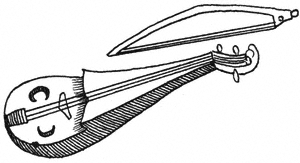

When were stringed instruments first used? As early as 1700 B.C., written records and artwork document the use of early stringed instruments such as the plucked cithara used in ancient Greece, Egypt, Assyria, and Asia Minor. [1] In the early tenth century, the bowed two-stringed Arabic rabab and the bowed lyra were used throughout the Islamic and Byzantine empires, [2] and this led to the development of the bowed three-stringed rebec, patterned after the Arab rabab and the Byzantine lyra. [3]
Were stringed instruments such as the the violin, viola, cello and double bass patterned after one of these early instruments? John Dilworth noted the difficulty of tracing the origins of modern stringed instruments when he stated:
Instruments played with a bow appear in European carvings and illustrations from around 900 AD, but interpretation is difficult, and the names given for them in texts vary and overlap. Broadly speaking, however, they fall into four categories: the rebec, the medieval and Renaissance fiddle, the lira da braccio and the viol. Of these, the first three are generally accepted as ancestors of the violin and viola, because of their playing positions and sizes. . . the distillation of the various families of instrument, such as the three-stringed rebec and the seven-stringed lira, into the four-stringed violin with carved back and front, provided a form which could easily be extended to the larger sizes for the consort, the viola supplying the middle voice and the cello as the bass instrument. The full name of the instrument, the ‘violoncello’, did not become widely agreed until the late seventeenth century.[4][5]
The origin of the double bass is even more difficult to ascertain, because scholars have differing views whether or not the double bass descended from the violin family or the viol family. The history of stringed instruments will be further discussed in unit 1.10.
© Copyright 2025 RK Deverich. All rights reserved.
Although this online bass class is provided free of charge, all rights are reserved and this content is protected by international copyright law. It is illegal to copy, post or publish this content in any form, and displaying any of this material on other websites, blogs or feeds is prohibited. Permission is given for individual users to print pages and perform music from this website for their personal, noncommercial use.